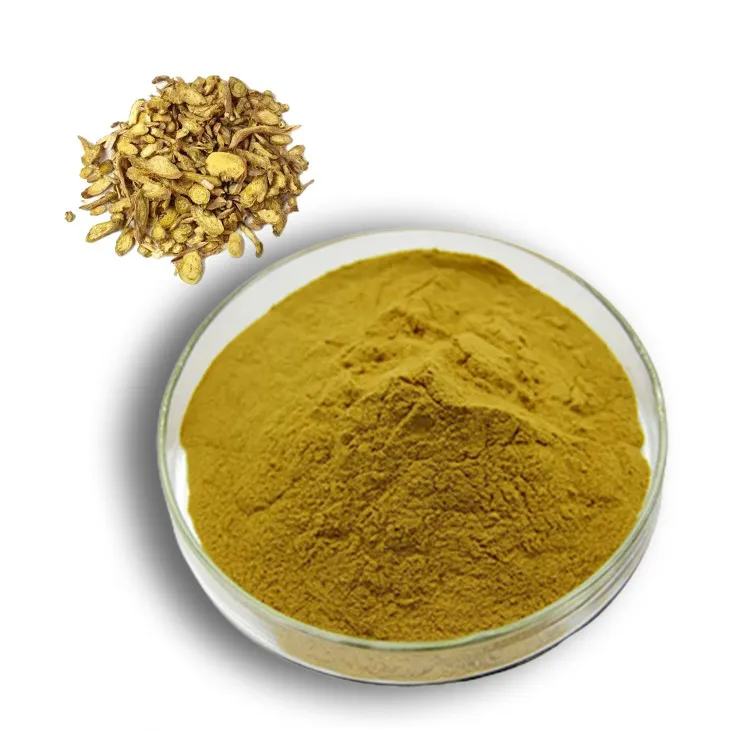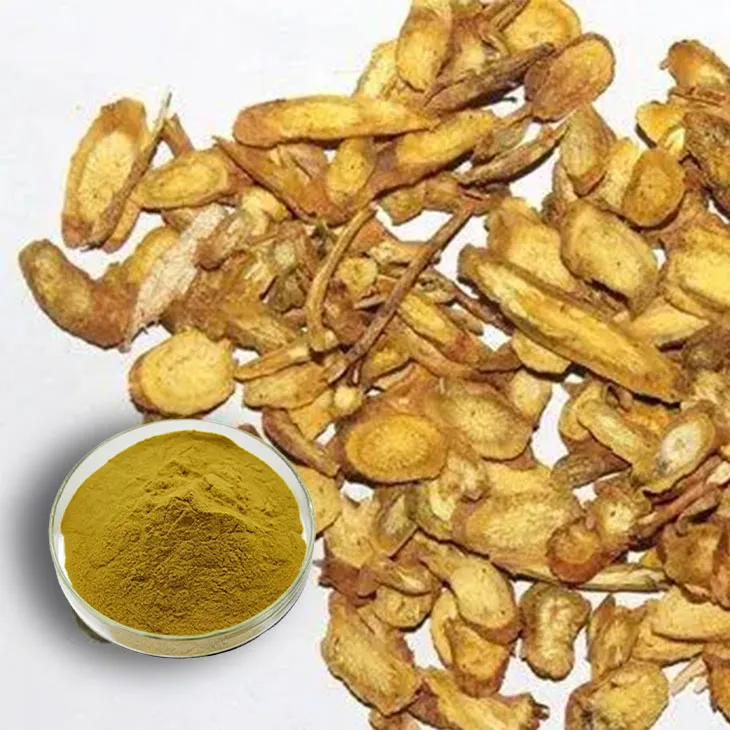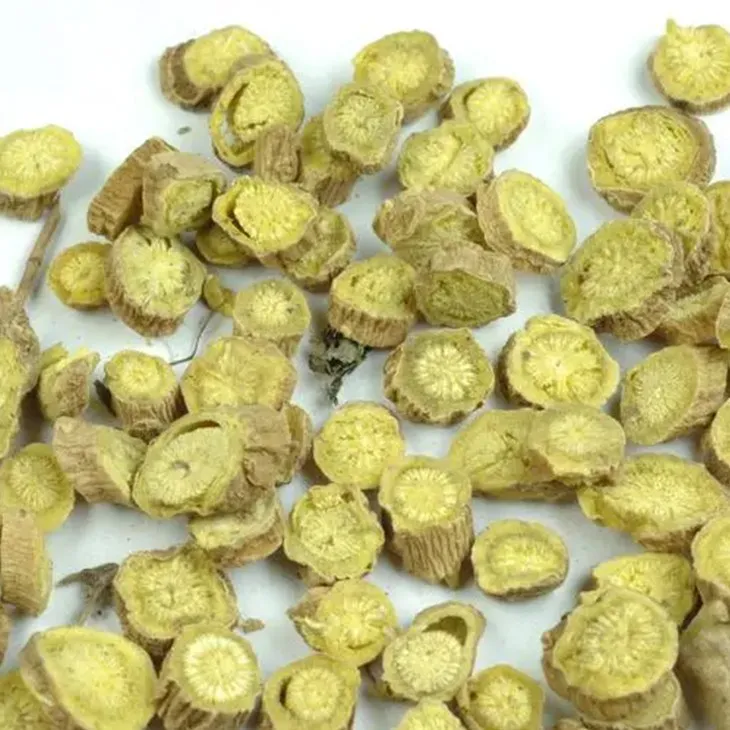- 0086-571-85302990
- sales@greenskybio.com
How to make powder with baicalin?
2024-11-26

1. Introduction
Baicalin, a compound with significant potential in pharmaceutical and other fields, has attracted much attention in recent years. The process of making powder from Baicalin is not only important for its practical applications but also requires a strict and detailed procedure. This article will comprehensively discuss the steps and key points in making Baicalin powder.

2. Collection of Baicalin - Rich Materials
The first step in making baicalin powder is to obtain baicalin - rich materials. Scutellaria baicalensis Georgi is a common source of baicalin. When collecting these materials, several factors need to be considered:
2.1. Source Selection
- The quality of the source plant can greatly affect the yield and quality of baicalin. It is important to choose plants that are grown in suitable environments, free from pollution and diseases. - For wild plants, ensure that the collection is legal and sustainable to avoid over - exploitation.
2.2. Harvesting Time
- The content of baicalin in the plant may vary with the growth stage. Generally, the optimal harvesting time needs to be determined through research and experience. For example, in the case of Scutellaria baicalensis Georgi, a certain growth period may ensure the highest baicalin content.

3. Pretreatment of Materials
After collection, the materials need to be pretreated before the extraction of baicalin:
3.1. Cleaning
- Remove dirt, debris, and other impurities from the collected materials. This can be done by washing with clean water. However, care should be taken not to damage the plant tissues during the cleaning process.
3.2. Drying
- Drying is an important step to reduce the moisture content in the materials. Different drying methods can be used, such as natural drying in a well - ventilated area or using drying equipment like a drying oven. The drying temperature and time should be controlled properly to avoid affecting the quality of baicalin. For example, a relatively low - temperature and long - time drying may be more suitable to preserve the active components.

4. Extraction of Baicalin
Once the materials are pretreated, the extraction of baicalin can be carried out:
4.1. Solvent Selection
- The choice of solvent is crucial for the extraction efficiency. Commonly used solvents include ethanol, methanol, and water. Ethanol is often preferred due to its good solubility for baicalin and relatively low toxicity. - The concentration of the solvent also affects the extraction. Different baicalin - containing materials may require different solvent concentrations for optimal extraction.
4.2. Extraction Methods
- There are several extraction methods, such as reflux extraction, ultrasonic - assisted extraction, and microwave - assisted extraction. - Reflux extraction: This method involves heating the mixture of the material and the solvent in a reflux apparatus. The solvent is continuously recycled, which helps to fully extract baicalin from the material. However, this method may require a relatively long extraction time. - Ultrasonic - assisted extraction: Ultrasonic waves are used to disrupt the cell walls of the material, increasing the mass transfer rate and improving the extraction efficiency. This method is relatively fast and can be carried out at a lower temperature, which is beneficial for preserving the active components. - Microwave - assisted extraction: Microwave energy is used to heat the solvent and the material rapidly. This can significantly shorten the extraction time. However, careful control of the microwave power and extraction time is required to avoid over - extraction or degradation of baicalin.

5. Concentration of Baicalin Solution
After extraction, the obtained baicalin solution usually has a relatively low concentration, so concentration is necessary:
5.1. Evaporation
- Evaporation is a common method for concentrating the baicalin solution. This can be achieved by heating the solution under normal pressure or reduced pressure. - Under normal pressure evaporation, the solution is heated directly, and the solvent is gradually evaporated. However, this method may require a relatively high temperature, which may have some impact on the stability of baicalin. - Reduced - pressure evaporation can be carried out at a lower temperature. By reducing the pressure, the boiling point of the solvent is lowered, which is more suitable for heat - sensitive baicalin.
5.2. Reverse Osmosis
- Reverse osmosis is another method for concentrating the baicalin solution. This method uses a semi - permeable membrane to separate the solvent from the solution. Under the action of pressure, the solvent is forced to pass through the membrane, while baicalin is retained on the other side of the membrane, achieving concentration.
6. Crystallization of Baicalin
Concentrated baicalin solution needs to be crystallized to separate baicalin from the solution:
6.1. Cooling Crystallization
- Cooling crystallization is a simple and commonly used method. By cooling the concentrated solution, the solubility of baicalin in the solvent decreases, and crystals gradually form. - The cooling rate is an important factor affecting crystallization. A too - fast cooling rate may lead to the formation of small and irregular crystals, while a too - slow cooling rate may result in a long crystallization time.
6.2. Evaporative Crystallization
- Evaporative crystallization is carried out by further evaporating the solvent in the concentrated solution. As the solvent is continuously evaporated, the concentration of baicalin in the solution exceeds its solubility, and crystals are formed. - This method is suitable for solutions with relatively high baicalin concentrations. However, careful control of the evaporation rate is required to ensure the quality of the crystals.
7. Drying of Crystalline Baicalin
After crystallization, the obtained baicalin crystals still contain some moisture, so drying is required:
7.1. Vacuum Drying
- Vacuum drying is an effective method for drying baicalin crystals. By reducing the pressure in the drying chamber, the boiling point of water is lowered, which allows the moisture in the crystals to be removed at a lower temperature. This helps to preserve the quality of baicalin. - The drying time and temperature should be adjusted according to the amount of crystals and the initial moisture content.
7.2. Freeze - Drying
- Freeze - drying is another option for drying baicalin crystals. The crystals are first frozen, and then the ice is directly sublimated from the solid state to the gaseous state under reduced pressure. This method can better preserve the structure and activity of baicalin. However, it is relatively expensive and requires special equipment.
8. Grinding of Dried Baicalin
Finally, the dried baicalin needs to be ground into powder:
8.1. Equipment Selection
- There are various types of grinding equipment available, such as mortar and pestle, ball mill, and pulverizer. - Mortar and pestle are suitable for small - scale grinding. They can be used to manually grind the dried baicalin into a relatively fine powder. However, this method is time - consuming and labor - intensive. - Ball mill is often used for larger - scale grinding. It uses grinding balls to crush the baicalin. The rotation speed and the size and material of the grinding balls can be adjusted according to the requirements of the powder fineness. - Pulverizer can quickly grind the dried baicalin into powder with a relatively uniform particle size. However, it may generate heat during the grinding process, which may have some impact on the quality of baicalin.
8.2. Grinding Parameters
- The grinding time and speed are important parameters affecting the powder fineness. A longer grinding time and a higher speed may result in a finer powder. However, excessive grinding may also lead to the aggregation of powder particles or the degradation of baicalin. - The particle size of the baicalin powder can be measured by methods such as laser diffraction particle size analysis to ensure that it meets the requirements for different applications.
9. Conclusion
The process of making powder from baicalin involves multiple steps, from the collection of raw materials to the final grinding. Each step is interlinked and requires strict control of various parameters to ensure the quality of the baicalin powder. With the increasing demand for baicalin in various fields, the improvement and optimization of this powder - making process will have important significance for its further development and application.
FAQ:
What are the important steps in making powder with baicalin?
The important steps include collecting baicalin - rich materials, concentrating the baicalin solution (through evaporation etc.), inducing crystallization, carefully drying the obtained crystalline baicalin, and finally using mechanical methods like grinding to turn it into powder.
Why is concentration of the baicalin solution necessary?
Concentration of the baicalin solution is a preliminary step as it helps in preparing the baicalin for further processes such as crystallization. It makes it easier to separate baicalin from the solution during the subsequent steps.
How can crystallization of baicalin be induced?
There are specific methods to induce crystallization of baicalin. This can be achieved by adjusting factors such as temperature, pH, or by adding certain substances that promote crystal formation. However, the exact method may depend on the nature of the baicalin solution and the surrounding conditions.
What should be noted during the drying process of crystalline baicalin?
During the drying process of crystalline baicalin, it is important to ensure that all the remaining moisture is eliminated without causing any damage to the baicalin crystals. The drying conditions such as temperature and drying time should be carefully controlled to maintain the quality of the baicalin.
Are there any special requirements for the grinding process to make baicalin powder?
The grinding process should be carried out carefully to ensure that the baicalin is evenly ground into a fine powder. The equipment used for grinding should be clean and suitable for handling the baicalin. Also, the grinding should be done in a way that does not cause over - heating or chemical changes to the baicalin.
Related literature
- Title: Studies on Baicalin: Properties and Preparation Methods"
- Title: "Baicalin: From Extraction to Powder Formation - A Review"
- ▶ Hesperidin
- ▶ Citrus Bioflavonoids
- ▶ Plant Extract
- ▶ lycopene
- ▶ Diosmin
- ▶ Grape seed extract
- ▶ Sea buckthorn Juice Powder
- ▶ Fruit Juice Powder
- ▶ Hops Extract
- ▶ Artichoke Extract
- ▶ Mushroom extract
- ▶ Astaxanthin
- ▶ Green Tea Extract
- ▶ Curcumin
- ▶ Horse Chestnut Extract
- ▶ Other Product
- ▶ Boswellia Serrata Extract
- ▶ Resveratrol
- ▶ Marigold Extract
- ▶ Grape Leaf Extract
- ▶ New Product
- ▶ Aminolevulinic acid
- ▶ Cranberry Extract
- ▶ Red Yeast Rice
- ▶ Red Wine Extract
-
Hawthorn powder
2024-11-26
-
White Peony Extract
2024-11-26
-
Mango flavored powder
2024-11-26
-
Polygonum Cuspidatum Extract
2024-11-26
-
Soy Extract
2024-11-26
-
Lily extract
2024-11-26
-
Thunder God Vine Extract
2024-11-26
-
Licorice Root Extract Powder
2024-11-26
-
Hesperidin
2024-11-26
-
Mangosteen extract powder
2024-11-26





















